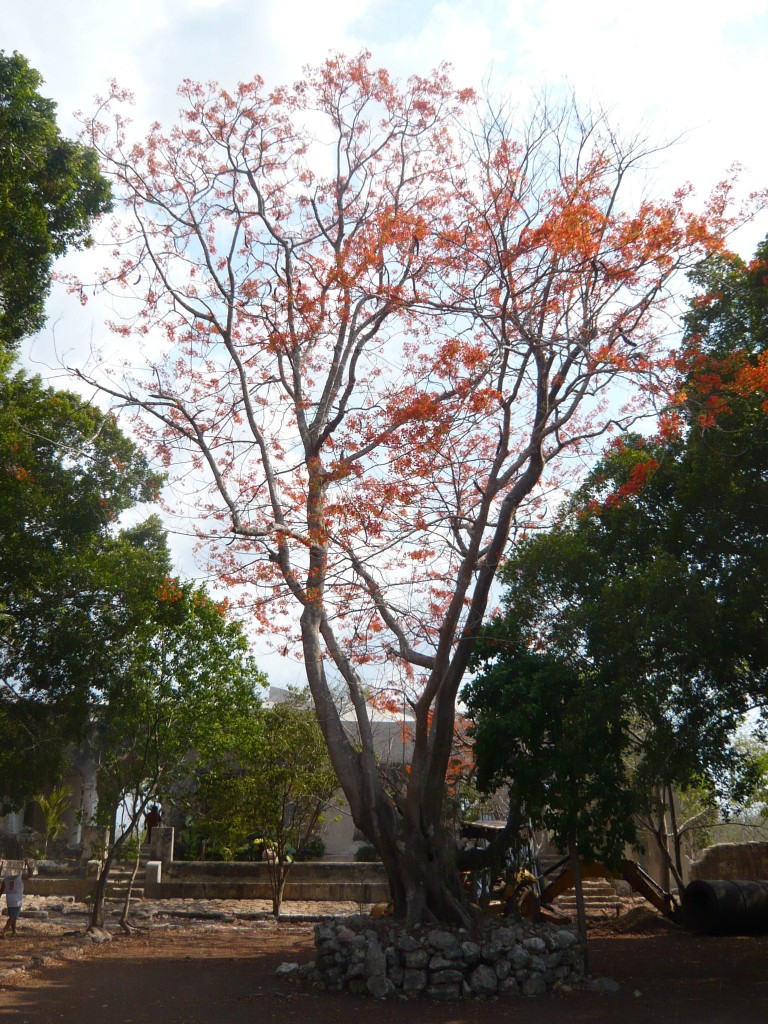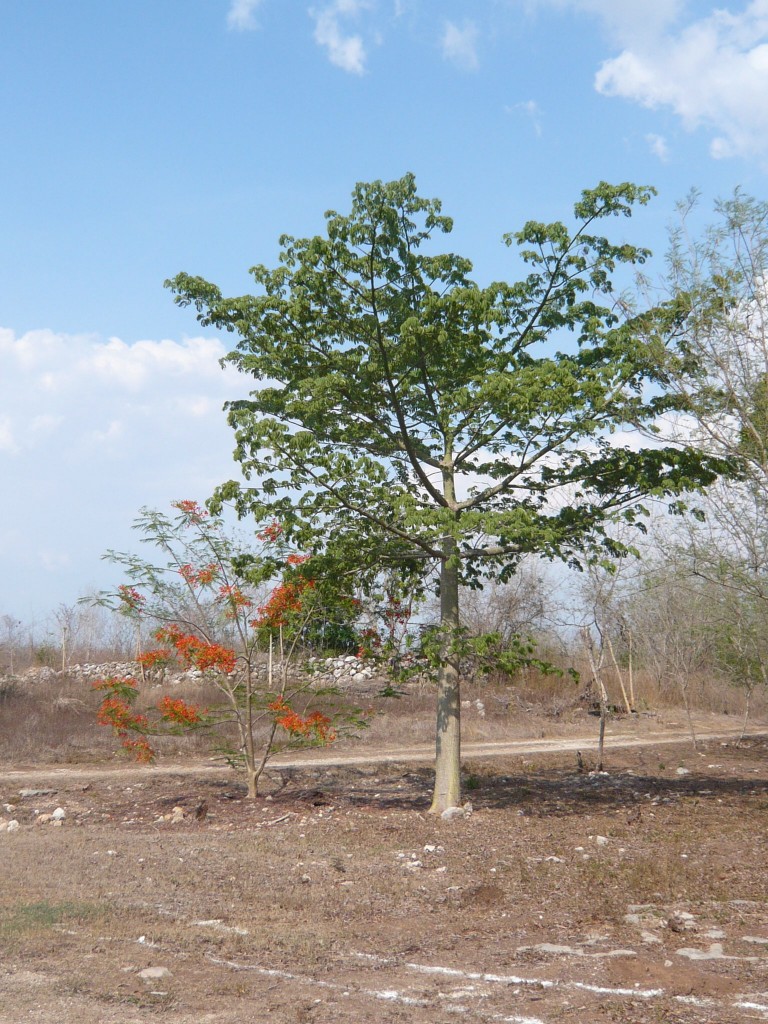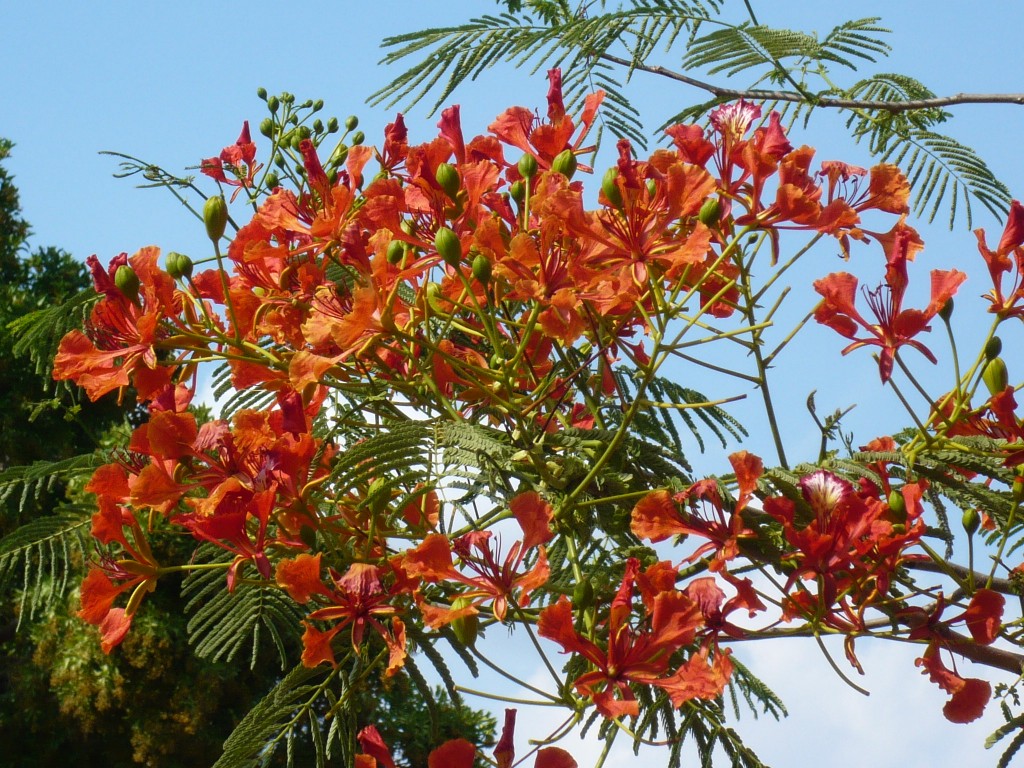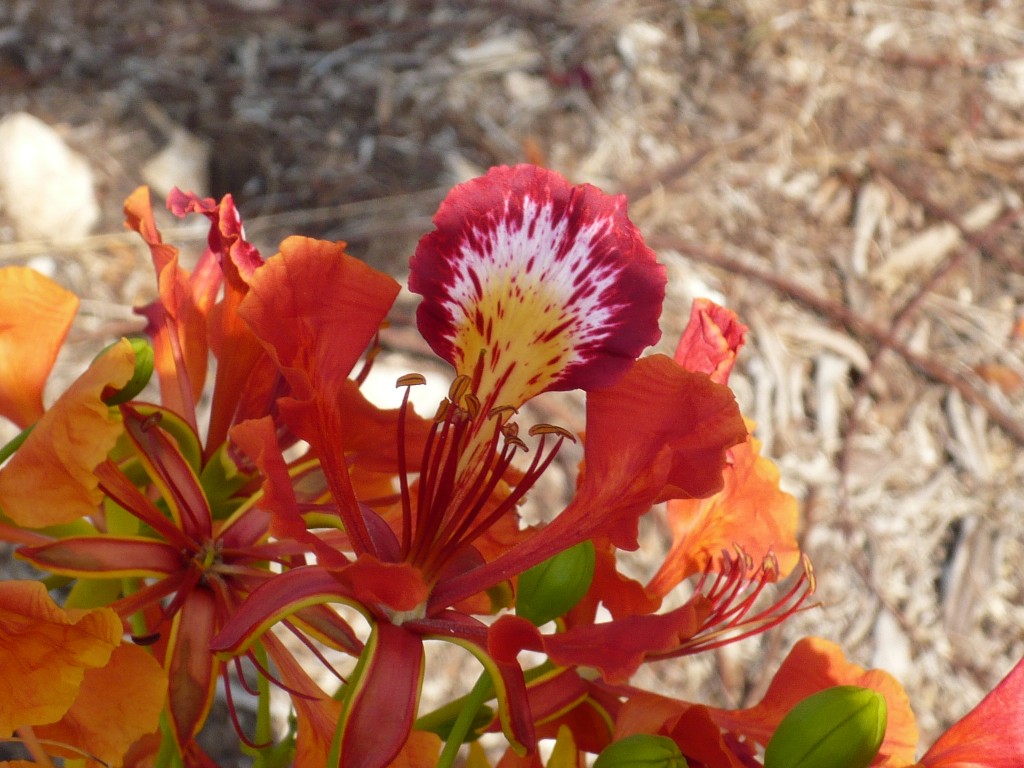by germinatrix | May 20th, 2009
Down at the job site outside Merida, things are dry and dusty – but as we drove up I saw a glorious beauty had sprung up in our midst … one of the huge trees in the courtyard is a Delonix regia, or as they call it in the latin countries, the Flamboyan.
 a huge flamboyan, bursting into flower
a huge flamboyan, bursting into flower
These amazing deciduous tropical trees flower before they leaf out, like Jacarandas. The sight of an avenue of them in full bloom must have given me a stroke, because I have no pictures of any of the hundreds I saw in Merida, save the ones on the job site. And these, while lovely, are not the best examples of the tree – they are struggling in a dry, hectic construction zone. But still, they bravely burst forth with whatever they have to give, and I am thrilled! When we get water on these babies, they will be GLORIOUS! Will you look how big the one in the first picture is?
 gasp! a baby delonix in the distance!
gasp! a baby delonix in the distance!
Poking around, what do I spy? Another, smaller Flamboyan, cuddled up next to a Ceiba (another favorite tree of mine! Lucky me!). I walked over to investigate – I’d never seen these eye-singeing flowers close up.
Now, these trees are held in the highest regard all over the tropics. As I was explaining to pal ESP of the East Side Patch, people freak out over them. They talk about them, and their eyes slightly mist over. I wouldn’t be surprised if the flowers were used in some obscure fertility rite – I could see them adorning the body of a virgin before she was married to Xchtylquotyl (a Mayan God I just now made up).
The day was windy, so it was hard to get a good shot of these incredible blossoms – and if you’ll believe it, the color in person is way more saturated than in these photos.
 a bouquet, just for us…
a bouquet, just for us…
I am so happy that we have some of these trees already on the property. I want more! I have room for more – so why not? Can you imagine dozens of these all flowering at once? (You wouldn’t have to imagine if I hadn’t gone into a fugue state and not snapped even one photo of the literally hundreds of these trees I saw).
 is it an orchid? or?
is it an orchid? or?
The complexity of the flower is incredible. No wonder everybody goes crazy over the Flamboyan. It is pretty awe-inspiring, all this color and detail and sexiness. And the bipinnate leaves, all soft and feathery – oooo la la!
Delonix regia – just the kind of tree a girl can get behind!


This is my favorite flowering tree! Around here (deep south Texas) we call it Royal Poinciana. After being in the ground for seven long years, mine is finally blooming this year. I’m so excited, I can’t quit posting pictures!
Beautiful! One would look so lovely in the danger garden near the orange shade shack! I’ll have to dream though huh? Portland isn’t exactly the tropics. Thank you for introducing us!
So gorgeous! I love it! Do they grow in so cal? You lucky lady having them on your project site!
Oh, this has always been one of my favourite trees. We are actually planning to move to a new house in a few months and I have my two flambouyant saplings (grown from seeds) to be placed at the entrance. The whole lot needs to be landscaped from scratch as the builders ( gainst our insturctions) cleared it all off.
Its great that you are getting to work on projects in tropical climes. Hmm maybe we can do a trade-free board and lodge on a resort island in return for part time landscaping device-other part time spent on beach.
These are some of my favorites, I was in Merida yesterday, first time in a couple weeks and snapped all kinds of pix myself. They are blooming out here in Chelem too but no where near as many.
I have never had wanderlust, never really felt the need to pack up and move to another town, but the gardening options that open up when you move south, they are tempting.
Hi Ivette
I seriously think this may be one of the most beautiful trees that exists on the planet earth! Isn’t it?
I have been doing a lot of googling on the Delonix regia since we last corresponded, and some of the specimens pictured are just out of this world. The Bonsai versions of this flame tree are simply insane, and I am not a bonsai person…at least not yet!
I really enjoyed the introduction to this tree Ivette, although I am pretty sure it is not my mystery shrub, it is close though! I found out that this tree does grow in the southern part of Texas (Rio Grande valley) so I will seriously be on the look out for it from now on, to give it a try…oh and I will find space for it!
Cheers.
ESP.
Oh and ..”obscure fertility rite”? …adorning the body of a virgin?
I would not have expected anything less!
How funny! Another great blog (with great photography) that I post-suscribe to posted this…
http://earthmother45.livejournal.com/153035.html
Wow you guys! I turn my back for a day of work and look what happens! This tree has many fans!
Hi Mary Beth! And congrats on the blooming of your beautiful Royal Poinciana/Flamboyan – what a beauty! If your tree were mine, I’d be carrying pictures of it in my wallet and whipping them out to show anybody and everybody. Seven years is a long time to wait, but it’s worth it for this kind of a show…
Oh, Loree! If ONLY! Wouldn’t it be lovely in your garden? I totally see it – but yes, I think you’d have to give it an electric blanket and a humidifier to make it through your winters. But a girl can dream, right?
Hey Sue! You know, if they DO grow here, I can’t imagine why I haven’t seen them – they are so crazy beautiful! Sunset only puts them in z 22, 23, and H2 – but I really doubt the 22 and 23 part of that – I’m in zone 23, and we have had killing freezes w/in the past 3 years. But still, I find it strange that I’ve never even seen even a shrimpy wannabe one in a botanic garden or at the LA Arboretum – surely someone would have taken the risk for this lovely tree, whether or not we have the proper temperature and humidity! Hmmmmm…
Nicole, that kills me – a pair of these sexy trees flanking your entrance? HOT! Lucky duck! (see – I become a 4 year old when I can’t have what I want!)
And what an offer! How is anyone supposed to say no to THAT?
Hello Teresa! So you saw the fireworks of blooming Flamboyans in Merida – we were just a few days apart! I was amazed when I got off the plane and say the blazes of bright red/orange. I did another tropical garden in Puerto Rico about 6 years ago, but I was never there to see the Delonix in bloom. This was my first time, and it was a doozy!
Btw, great info about moving to the Yucatan on your site! I love Mexico so much, esp. the Yucatan – that beach property is VERY tempting!
Megan! It seems that way, doesn’t it? But the grass is always greener. I think that it is fantastic to be able to have our home gardens where we hone our expertise within a certain climate, and then to travel and collect mental images for our dream gardens – even if we can never really plant them!
Dear ESP!!! I agree wholeheartedly – this tree is unbelievable. It is easy to see why everyone in the tropics loves the Delonix regia – in fact, I think 3 or 4 different countries claim it as their national tree! It has everything, in my opinion – the leaves are lovely, the flowers are out of this world, and it has a naturally attractive umbrella- like shape. What more can anyone want? Besides money?
I have to check out the bonsai versions! Insane? I’m THERE!
I wonder what the mystery shrub is – I will keep on thinking. I MUST know!
Oh and THANK YOU for giving me the link to Earthmother 45! Now THAT is what a Flamboyan looks like – that shape! That color! I’m sure that tree stops traffic. I would want to pitch a tent under it and live there for a while!
… and another big thanks for inspiring this post! It all started with your Caesalpinia – and ended with flowery virgins and imaginary Mayan gods! What a trip…
if you love royal poinciana, google the african tulip Spathodea campanulata. it’s blooming right now in sfl too:) don’t mean to be bragadocious, but i love me some trees.
Just ran across your blog — I live outside Merida (I think I recognized my pueblo in some of your vivero photos), and have gardened here for the last twelve years.
Re, flamboyanes, a few things to keep in mind —
these are fast-growing trees (from seedlings, they will be flowering in less than five years), but also have very intrusive roots (note the raised sidewalks in their proximity in Merida).
They do lose most of their leaves in the dry season, so underplantings will be subject to the very harsh sun (March, April, May) at the end of the dry season. But, during the rainy season, in contrast, the shade below these trees is very dense, so a whole different environment for underplants (in our quinta, this dense shade in the rainy season is kind of a plus, since after a few years weed growth below these trees is minimal). The seed pods (which, like the flowers they develop from, are abundant) are quite neat looking as well (good for craft projects) — but could be considered messy.
Consider hunting out some Hamelia patens (hummingbird bush, firebush)– this is a native shrub, in the coffee family, that humming birds and butterflies love. It loves to be pruned back, hard. Also, for scent, consider Murraya paniculata, locally referred to as “limonaria” — sometimes called orange jessamine — this small-leaved evergreen has multiple flowerings throughout the year, with an intoxicating order (think super-jasmine). It can be pruned (and in fact, is some of the boxy shrubs that you were ranting about in a previous blog), or left to grow into a large shrub/small tree. The red berries attract birds, as well.
Another small tree that does very well is Thevetia peruviana (called yellow oleander, but not related to oleander) — there are yellow and peach-colored variants. It’s a very fast-grower, and quite delicate and lovely in appearance. There are other species of Thevetia (like T. ahouia — “huevos de perro”) that are attractive shrubs as well.
I saw that you mentioned Kalanchoe — have had great luck with several different species, most of which seem to tolerate the absence of soil and baking heat of the “spring” quite well.
Rhoeo spathacea is used (over used?) a lot here — often in quite ugly (to me) “formal” garden designs — but it is drought resistant and looks terrific if allowed to naturalize, and interplanted with clumbs of Sanseveria (mother-in-laws tongue; lengua de vaca). There is a small variety found in nurseries, but I prefer the larger variety (it was already naturalized on our quinta).
Good luck with your project — gardening here has been a whole new experience…unlearning everything, tossing out all my assumptions about soil, shade/sun, etc. It’s a challenge!
And, apologies for the long comment!
Ooooo …Easftlaud / Erin – I LOOOOVVVVVEEE that tree! The flower buds are amazing! They look like claws! Do you grow one? If only I had room for one more tree. Maybe I can cut down my sycamores… who needs a big old protected California native lording over my yard when I could have the Spathodea!
Thanks for the heads up – I owe you one!
MCM, Thank you for all the info … these tips are VERY appreciated! Only a fool would go into a foreign climate and get down with making a garden w/o listening to the gardeners who actually dig and grow there, day in day out!
I am very excited about the Hamelia – it’s a plant I’ve admired forever, but haven’t had the occasion to plant it… and now I’m gonna WORK it!
Thevetia is a shrub I love, and so being able to design with it is like bringing a friend along – I was so happy to see them planted all over Merida and looking beautiful!
I am using ALL the plants you’ve mentioned … there is alot of garden to fill! Please drop by and give me some support whenever you feel like it, I am very happy for the participation of my blog friends!
And there is no such thing as too long a comment here at The Germinatrix!
OK — I’m thrilled for a chance to chat about Yucatan plants and gardening…
We have two “mainstay” orchids — Cyrtopodium punctata (beeswarm orchid) — it blooms very reliably every spring — large stalks with huge clusters of small (1-2cm) golden brown/yellow blooms)…they last several weeks. This orchid also naturalizes — from a few plants rescued from the coastal dunes, they have popped up throughout the orchard — they seem to especially like the bases of bamboo stands, or the bamboo leaf mulch below palms.
the other is — Schombergkia tibicinis — again, a spring bloomer, a bit less reliable (those in full sun are the best bloomers) — single, very long stalks with numerous blooms that open in sequence, bottom to top. Blooms are fairly large (3-5cm), and very striking.
Another much more subtle orchid, but also one that naturalizes well, is Oeceoclades maculata — monk orchid. Blooms are very small (less than 1cm), and subtly colored. We put these in small pots, and bring them into the house when ready to bloom, so that they can be appreciated.
Back to small trees/shrubs — Jatropha multifida (coral plant) sprouts VERY easily from seeds, and quickly grows to a small tree. They’re drought resistant, but of course look much better if given adequate water — lacy grey/green foliage, red blooms (multiple blooms throughout the year).
Bigger tree — Bursera simaruba (gumbolimbo in Florida, chaKA in Maya). These are often used as “living fences”, since they sprout from branches stuck in the ground. In fact, we’ve stuck BIG branches in areas that are essentially piles of escombro (rock/cement rubble), thrown a bunch of organic waste (bamboo leaves, whatever) on top, and in a year or two they’re well-established trees. The bark is lovely — peely green-red-brown, and birds are very attracted to the small fruits (orioles, especially, in the spring). They are deciduous, but only for a short time if they get some watering.
Plumeria (frangiapani) — Plumeria rubra is common in gardens here — flowers in pink/white, red, yellow, but almost always lose their leaves in the dry season, even with fairly regular watering. Whether you like the rather stark structure of the bare tree is a matter of taste. However, the native species, Plumeria alba is theoretically evergreen, and with water is definitely evergreen. The leaves are a bit smaller, and more obtuse (rounded at the ends), and the flower is pure white. You can see these in the scrub forest (monte) at the end of the dry season — the white flowers really stand out, kind of like dogwoods in the deciduous leafless spring woods of the southeast US. Again — both of these are easily started from quite large hard cuttings — like whole branches.
A small plant — Anthurium schelctendali — this is a native anthurium, very common just inland from the coast (in the marsh). It occurs under thorny shrubs, often along with Cryptopodium. It grows best among large rocks. The leaves do seem to be subject to insect predators. The fruit is a stalk with small red berries (typical anthurium stalk), and the plants propagate easily from the seeds, though they take a while to get established.
Thanks (again) for the opportunity to talk about Yucatan plants and gardening!
PS — FYI, this particular spring is apparently the driest in about 25 years, according to the local paper. “normally”, there is a good rain in February or so, and some smaller showers in April, that keep things going. Last year was unusually wet. We moved here during a three-year drought (clueless–assumed that was “normal”), which was good, since we thought that was what it was always like.
WOW MCM! Talk about stepping up to the plate!
Thanks for this! I am familiar with some of these plants, but don’t have a background on orchids at ALL, and would love to use some on this project! And I am very excited to use Plumerias – I am putting several in areas that will be planted with tougher, dryer things with a canopy of Ceibas and Piich, so that the stark branches of them out of bloom will have a sculptural resonance.
You are being so generous – I appreciate it!